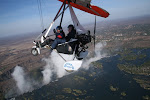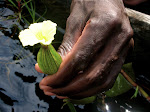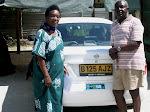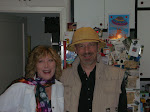


Maun, Botswana
Sept. 29, 2008
With only a couple of music CDs with me on this journey, I have incessantly played an old one I have by NRBQ – remember that bluesy, piano-pounding Kentucky group, anyone?
It is a great 4WD companion for singalongs in my rented Toyota Surf on sandy roads, but it is the source of many an earworm. An earworm is a song you cannot get out of your head. Like a gnarled tape it reverses and plays over and over again. It can be a terrible song (“Do you like pina coladas,” for example, or “Honey” by Bobby Goldsboro come to mind. Sorry, pal, if I gave you an earworm just now.) But it can be a fabulous song, usually a single line or two that gets stuck in the brain. NRBQ’s ditties belong to the latter category.
NRBQ has infected me with several earworms lately, and one is, “There ain’t no free. There ain’t no free…It might be credit. It might be barter. But they’ll always find a way to make you Pay! Pay! Pay!”
And that brings me to my latest excursion.
When I came back from Leroo La Tau on Friday, I got word of a dandy offer. I could hop on a bush plane on Saturday afternoon, fly to Shakawe, meet a guide with a game truck crew who would take me to the Tsodilo Hills in the Northwest Kalahari for an overnight camping trip and drive me back to Maun on Sunday. A Norwegian civil engineer on assignment to Botswana’s roads department in Gaborone had booked the trip and paid for it; there was room for me to come along for free. (cue to sing along with NRBQ....”There ain’t no free.”)
I had been hoping to go to the Tsodilo Hills around Oct. 1 on a trip with a guide friend to meet his sister, a basket weaver in Etsha 6 on the western edge of the Okavango Delta. But on Friday, I had felt a distinct call in my morning quiet time to go to the hills and sleep under the stars at Female Hill (if it sounds woo-woo, too bad; it’s the truth.) And voila. Here comes the offer for a free trip a few hours later. I think I’ll answer the call, I thought to myself, and say yes right away.
The Tsodilo Hills are Botswana’s lone World Heritage Site. They are sacred to the San people, and even today people make pilgrimages to the hills to wash in the spring water, which is considered holy. Rising 400 meters above the bush scrubland, the rock outcroppings inspire awe and any flatlander’s desire to explore. On these hills are about 2,000 rock paintings dating back 3,000 years – orange-colored renderings of kudu, rhino, giraffes, zebra, dancing people, geometric shapes. It is said that the spirit of every animal and insect is here. The San believe that powerful gods live in the caves of Female Hill from which they rule the world and can cause harm and misfortune to offenders.
I must sadly report that my group of 5 apparently contained an offender. Could be me, for all I know. Here are the facts:
John, a 62-year-old Norwegian family man, and I were dropped off at the quaint, thatched airport gazebo in Shakawe by the two pilots of a four-seater plane. No one was there to greet us. I found an official Botswana military cap sitting on a shelf and a torn canvas tennis hat on a counter, the only signs humans had been there lately. The pilots were concerned. Would we be ok? Sure, I’ve got the booking-agency representative’s emergency phone number. The pilots flew away. John and I stood and waited. No one ever answered the emergency number. I enlisted help from my friends at Desert & Delta, who went to work trying to assist me. John had no water, and I had a few sips left in my bottle. I wondered how far we might need to walk. I wondered how long my cell phone battery would last.
Forty-five minutes later the game truck arrived. Such tardiness is way out of line in the protocol of meeting guests in Africa. Tourists drop down out of the sky often into grass airstrips in the middle of nowhere; someone must always be there to greet them, offer water and move them safely into vehicles, away from elephants and predators. While we didn’t have to worry about wild animals at the tarred airstrip in Shakawe, we did have legitimate concerns about where the heck we were and where the heck we might need to be before dark.
The guide Thabo was most apologetic, and I figure it was not his fault that the expedition arrived late. The culprit appeared to be Kilos, the cook in the crew. He was off his rocker drunk as a skunk. The other crew member was Linda, sober and efficient.
We were late, and we needed to be at the campsite before dark. My heart sank when I realized the guide was counting on Kilos to direct him to the proper turns and bush tracks. Ai yi yi. What a predicament. Directing meant that Kilos would occasionally flap his right hand in some direction before he would fall back into his seat. We were speeding in that Land Rover – up to 80 kph, which is teeth-rattling fast. You can only duck your head to keep the wind and sand out of your eyes. Forget seeing the scenery, not that there was much variation in the desert surrounding the hills. We did stop quickly once to get out where the sign said “Tsodilo view;” because of smoke from bush fires I couldn’t see anything. I chose the occasion to say to Thabo that the cook was drunk off his butt.
“I’m trying to make sure you don’t notice. He’ll lose his job,” he told me.
Sounds about right for a penalty. How could John and I not notice, especially when the crew stopped to collect firewood and Kilos contented himself with trying to pick up and drag a log big enough to span a river? Needless to say, he failed. And how could we not notice when he stepped from the truck, turned his back to us a few feet away and peed in the grass? Or when he sat with his finger up his nose for quite a while. I felt my appetite dwindling.
We stopped for John to take a photo of the sun slipping behind Male Hill. (The Tsodilo Hills include Male Hill, Female Hill, Child Hill.) How we powered through the bush at top speed past thorn branches without serious injury I don’t know. But we made it in one piece. We worked together hurriedly to set up camp at dusk and in the dark. Kilos fumbled but managed to cook something for us and not burn down the park. Thabo ate with John and me. At one point John’s comment about a young woman he had met eating like a horse tickled Thabo, which prompted Thabo to spit out his red wine, all over me. At another point he said out of the blue how he was feeling bad because he had been “cross and aggressive” with his girlfriend the night before. When we had made a quick stop before the park’s entrance at a local village, Thabo had gone to see the head man to request a guide for the paintings tour the following morning and, unbeknownst to us at the time, to ask what he could do to make up for being “cross” with his girlfriend. He was mulling the situation over dinner, which, I guess, is why he brought it up.
I can only conclude that Thabo had an appointment with the avenging forces at Female Hill; poor John and I were the lucky bystanders. (“There ain’t no free….”)
During the night a dog barked warnings. I woke up to hear a man yelling in Setswana. A few English words were thrown in: “I’m going to KILL you! I’m going to DESTROY you!” It was Thabo. Somewhere out there in the dark, he was instructing us “to be very careful!!” Young men from the village were around, Thabo yelled. They wanted to invade our camp. They wanted to steal our food. I moved into a fetal position in my sleeping bag after hiding my wallet and camera under my pillow. How exactly should I “be careful?” That was about 1:30 a.m. At about 2:30 a.m. I heard what I imagine were lids being screwed on and pans rattling. I figured this was going to be a long night. I was right. The next thing that happened: a raging windstorm was upon us. Gusts of fine sand blew into my tent, covering everything in it and making me feel at times I was being buried alive. It’s a mystery how I got sand in my belly button, but I did while the fierce winds blew. The winds were still churning when we arose for breakfast; even the milk blew off the cereal in the bowl. You’d think we were on a ship tossed and turned by waves.
The sooner we could start the hike, the better. Female Hill, imposing and gleaming yellow in the early sunlight, awaited us. With local guide KT, Thabo and Linda, we started our climb. Those paintings were wonderful; they naturally set one’s imagination rolling back to the time when Botswana’s earliest tribes lived in the caves. And for me there was a definite vibe around the place, a certain energy I can’t define. Last year I read about Sir Laurens van der Post’s first experience of the hills. My Bradt guide gives you the nutshell version: In ‘The Lost World of the Kalahari,’ you can read the story of his first visit, “of how his party ignored the advice of their guide, and disturbed the spirits of the hills by hunting warthog and steenbok on their way. Once at the hills, his companion’s camera magazines inexplicably kept jamming, his tape recorders stopped working, and bees repeatedly attacked his group – and problems only ceased when they made a written apology to the spirits.”
The Tsodilo Hills museum displays an excerpt from van der Post about this phenomenon.
Early on our hike Thabo explained to me that he thought it was very possible Female Hill was working its magic on him. He went into full confession mode about how he had hit his girlfriend and how the police might be waiting for him in Maun with an arrest warrant. Would I consider going with him to see his girlfriend to “mold her opinion” of him. I couldn’t believe this. To relieve his conscience, he unknowingly picked as a confidant an American who has devoted part of her newspaper career to writing about the ravages of domestic violence. It was all very strange. Our conversation went like this:
Did your father hit your mother? I asked.
No. He hit me. He thought it was good discipline.
Would you ever hit a stranger on the street or one of your guests?
No, never, never.
Then why would you hit someone in your home, someone you say you love?
I don’t know. Alcohol, maybe? No, I don’t think that’s really it.
I don’t think so either. In the United States I have found that this happens when a man wants power or control over a woman. Could this be you?
Maybe. When you’re in the bush a long time, thoughts of jealousy come; maybe your woman is with another man. I don’t know what will happen. I want forgiveness.
I told him I would not go with him and make peace with his girlfriend. “In the U.S. we have a saying that if you make a mess, you clean it up,” I told him. It’s never ok to hit someone you love.
Thabo was quiet after that. When we got to the cave where the legends say the powerful serpent spirits live, he did not remain outside as he has done on his previous three visits. He went in, a trip that was part of the penance the village head man had instructed him to do. I stayed outside (I don’t like closed spaces), sat on a rock and closed my eyes to behold glorious colors in meditation. John was pleased with his trip into the cave. Thabo felt better.
We returned to the campsite, ate more of Kilos’ cuisine, which I don’t recommend, and broke camp. On the 5 _ drive back, John wisely sat in the passenger’s seat in the cab of the truck with Thabo. I sat in the game drive seats, my ears bursting with the noise of the wind, my eyes swelling from the grit and wind. I don’t think I’ve been that dirty since I made the four-day trek to Machu Picchu. My shower at home in Maun felt like a visit to a dream spa.
And my trip to Female Hill feels like a dream that unfolded in violent gusts under starlight. The company that led my excursion and to which I paid with cash tips and unexpected guidance counseling? AfrikaCalls. Considering my reveries last Friday, interesting name, that one. But my advice is hang up. There ain’t no free.



























